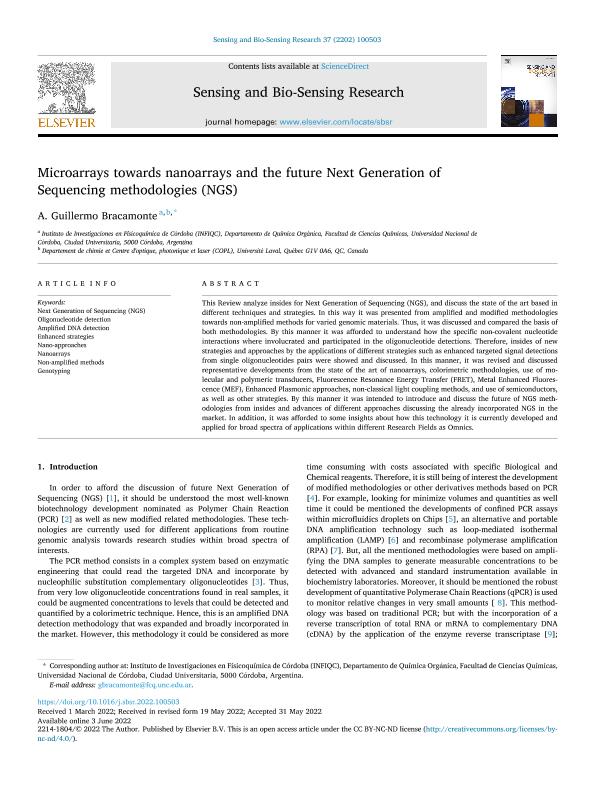Mostrar el registro sencillo del ítem
dc.contributor.author
Bracamonte, Angel Guillermo

dc.date.available
2023-10-31T19:02:22Z
dc.date.issued
2022-08
dc.identifier.citation
Bracamonte, Angel Guillermo; Microarrays towards nanoarrays and the future Next Generation of Sequencing methodologies (NGS); Elsevier; Sensing and Bio-Sensing Research, Elsevier; 37; 100503; 8-2022; 1-14
dc.identifier.issn
2214-1804
dc.identifier.uri
http://hdl.handle.net/11336/216712
dc.description.abstract
This Review analyze insides for Next Generation of Sequencing (NGS), and discuss the state of the art based in different techniques and strategies. In this way it was presented from amplified and modified methodologies towards non-amplified methods for varied genomic materials. Thus, it was discussed and compared the basis of both methodologies. By this manner it was afforded to understand how the specific non-covalent nucleotide interactions where involucrated and participated in the oligonucleotide detections. Therefore, insides of new strategies and approaches by the applications of different strategies such as enhanced targeted signal detections from single oligonucleotides pairs were showed and discussed. In this manner, it was revised and discussed representative developments from the state of the art of nanoarrays, colorimetric methodologies, use of molecular and polymeric transducers, Fluorescence Resonance Energy Transfer (FRET), Metal Enhanced Fluorescence (MEF), Enhanced Plasmonic approaches, non-classical light coupling methods, and use of semiconductors, as well as other strategies. By this manner it was intended to introduce and discuss the future of NGS methodologies from insides and advances of different approaches discussing the already incorporated NGS in the market. In addition, it was afforded to some insights about how this technology it is currently developed and applied for broad spectra of applications within different Research Fields as Omnics.
dc.format
application/pdf
dc.language.iso
eng
dc.publisher
Elsevier

dc.rights
info:eu-repo/semantics/openAccess
dc.rights.uri
https://creativecommons.org/licenses/by-nc-nd/2.5/ar/
dc.subject
AMPLIFIED DNA DETECTION
dc.subject
ENHANCED STRATEGIES
dc.subject
GENOTYPING
dc.subject
NANO-APPROACHES
dc.subject
NANOARRAYS
dc.subject
NEXT GENERATION OF SEQUENCING (NGS)
dc.subject
NON-AMPLIFIED METHODS
dc.subject
OLIGONUCLEOTIDE DETECTION
dc.subject.classification
Química Analítica

dc.subject.classification
Ciencias Químicas

dc.subject.classification
CIENCIAS NATURALES Y EXACTAS

dc.title
Microarrays towards nanoarrays and the future Next Generation of Sequencing methodologies (NGS)
dc.type
info:eu-repo/semantics/article
dc.type
info:ar-repo/semantics/artículo
dc.type
info:eu-repo/semantics/publishedVersion
dc.date.updated
2023-10-31T17:50:10Z
dc.journal.volume
37
dc.journal.number
100503
dc.journal.pagination
1-14
dc.journal.pais
Reino Unido

dc.journal.ciudad
Londres
dc.description.fil
Fil: Bracamonte, Angel Guillermo. Consejo Nacional de Investigaciones Científicas y Técnicas. Centro Científico Tecnológico Conicet - Córdoba. Instituto de Investigaciones en Físico-química de Córdoba. Universidad Nacional de Córdoba. Facultad de Ciencias Químicas. Instituto de Investigaciones en Físico-química de Córdoba; Argentina. Laval University; Canadá
dc.journal.title
Sensing and Bio-Sensing Research, Elsevier
dc.relation.alternativeid
info:eu-repo/semantics/altIdentifier/url/https://www.sciencedirect.com/science/article/pii/S2214180422000320
dc.relation.alternativeid
info:eu-repo/semantics/altIdentifier/doi/https://doi.org/10.1016/j.sbsr.2022.100503
Archivos asociados
